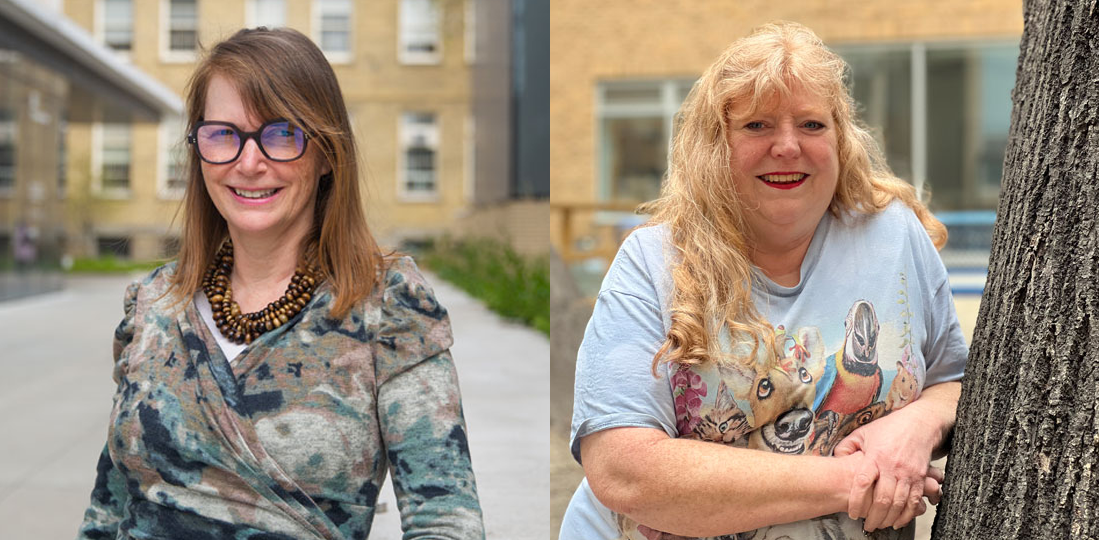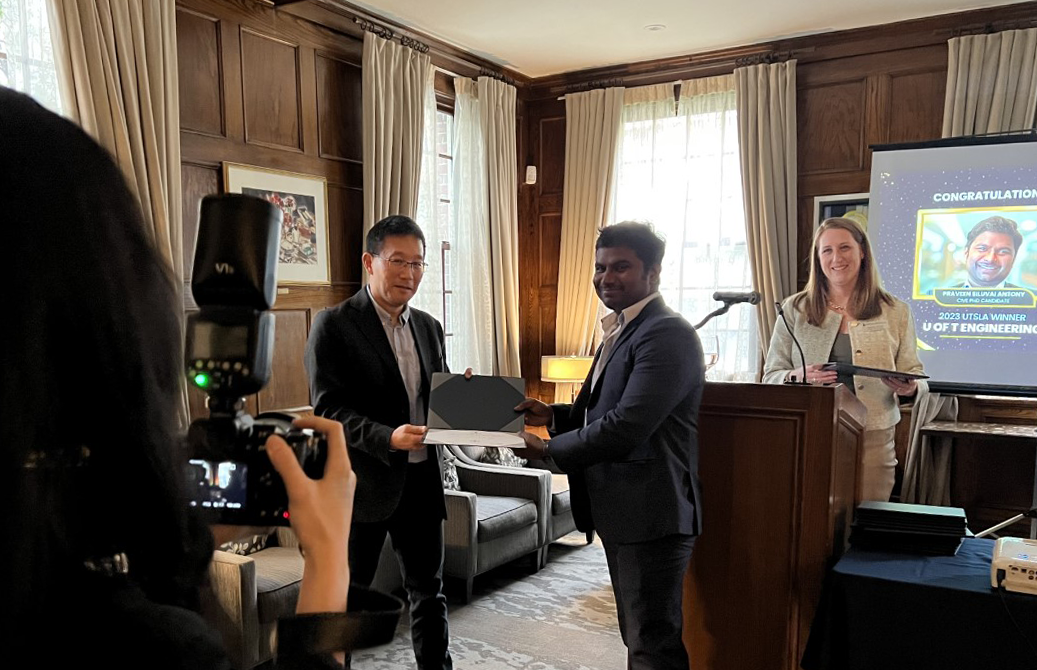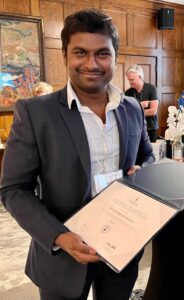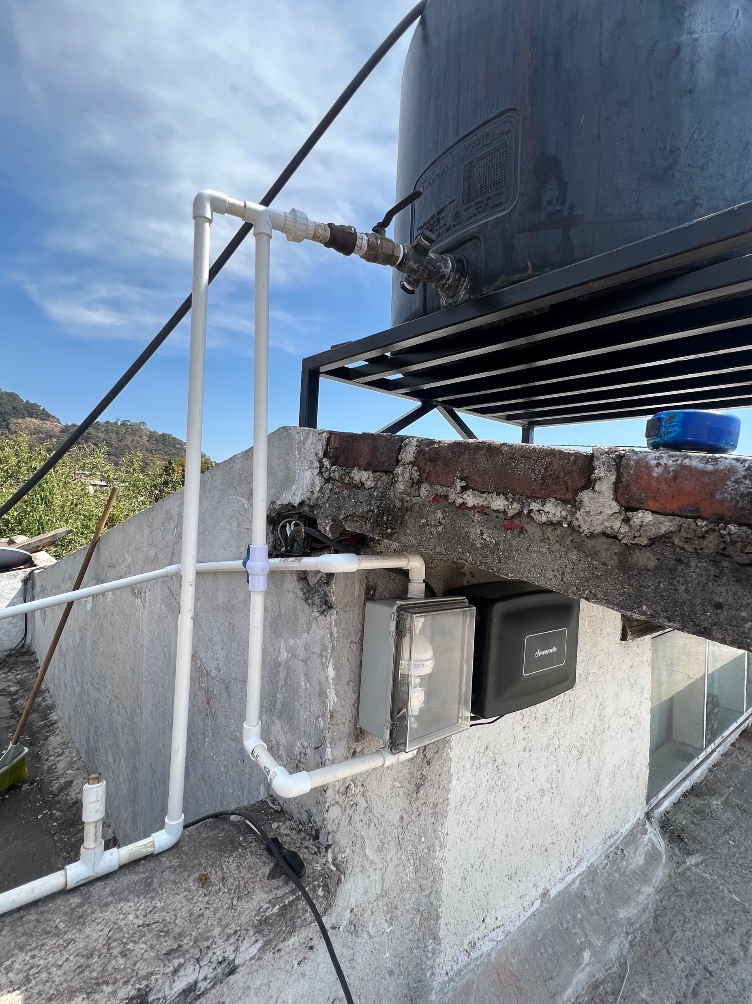
Congratulations to Diane McCartney on receiving Agnes Kaneko Citizenship Award and Michelle Deeton for being recognized with Harpreet Dhariwal Emerging Leader Award!
Diane and Michele are in the top ten of U of T Engineering faculty and staff to be honoured for their outstanding contributions to the Faculty. These awards recognize exceptional faculty and staff members for their leadership, citizenship, innovation and contributions to the Faculty’s teaching, service and research missions.
Diane McCartney
Agnes Kaneko Citizenship Award
Recognizing a staff member who has served with distinction and made contributions to the Faculty’s mission above and beyond their job description over a long period of time.
Currently a clerical/financial assistant in CivMin, Diane McCartney joined the department in 1982 as a secretary and has been a dedicated member of the Engineering community ever since. As the department moved from typewriters to computers to online technologies, McCartney was always an early adopter and played a leading role in training other staff.
Throughout these changes she has continued to be a role model in her above-and-beyond contributions to the department, both professionally and personally. Despite a heavy workload, McCartney consistently makes time to support our students, staff and faculty members. For example, she collects coupons for meal providers around campus and leaves them in a bowl for students to pick up, helping them to stretch their budgets.
McCartney’s office door is always open, and anyone is welcome to drop by to ask a question, look for help, or just dip into the candy jar she keeps on her filing cabinet. She is incredibly generous of her time and will always try to solve a problem for a student or colleague, whether or not it falls within the boundaries of her job. She also goes out of her way to foster an inclusive and welcoming community and acts as an unofficial goodwill ambassador for the department.
Michelle Deeton
Harpreet Dhariwal Emerging Leader Award
Recognizing a staff member who leads by example in their dedication to the Faculty’s mission and demonstrates potential to assume a more senior leadership role.
Michelle Deeton joined CivMin in 2017 as the Director of Finance and Administration, after serving as Acting Director for the Office of the Dean for nearly three years. Upon joining CivMin, Deeton faced the challenge of taking on a newly created leadership role at a time when the department’s business office was experiencing significant operational issues, including a near total turnover of staff. She quickly rose to the challenge and set about reorganizing the business office in a way that has made it considerably more effective.
Deeton has gone well beyond her job description to become the go-to person in CivMin for all policies related to human resources and finance, helping every community member strategically solve problems in these areas. Perhaps most importantly, she has led her team to completely change the culture of the business office, transforming it into a unit that is focused on providing support and guidance in following University policies, rather than simply enforcing those policies. In this way, her leadership has positively impacted faculty, staff and students across CivMin.
Deeton also plays a leadership role amongst her counterparts across the Faculty, promoting improvements to administrative procedures that affect all departments.
April 27, 2023 | Daily Commercial News by ConstructConnect


University of Toronto Alumni Association (UTAA) awarded Praveen Siluvai Antony, a CivMin’s PhD Candidate under the supervision of Prof. Daniel Posen, with a University of Toronto Student Leadership Award (UTSLA). The annual award was presented by Christopher Yip, the Deen of the Faculty of Applied Science & Engineering, at a Graduating Student Awards In-Person Celebration in the Faculty Club on Wednesday, April 26.
Praveen is pursuing research in the area of “Life cycle assessment, Biofuels, and Public policies” in the CivMin Department. See a past story on the CivMin website, where we chatted with Parveen about the award and his current work right after the nomination announcement: CivMin’s Praveen Siluvai Antony (PhD candidate) wins a UTSLA
April 26, 2023 | University of Toronto Magazine

Congratulations to Gonzalo Martínez Santos of the University of Toronto, who was awarded second place prize by Esri Canada for the 2023 Esri Young Scholars Award program. Martínez Santos is supervised by a faculty affiliate of the Smart Freight Centre.
Gonzalo Martínez Santos is a 4th-year student of Engineering Science at the University of Toronto majoring in Machine Intelligence Engineering and working on his undergraduate thesis project under the supervision of Professor Matthew Roorda.
Gonzalo is passionate about cities, mobility, and urbanism. His computational background and his experience with city modelling and visualization allows him to contribute to the development of urban generative design tools at the University of Toronto.
Gonzalo is grateful for this recognition by Esri Canada and says this award will further motivate his career aspirations:
“I am delighted to have been awarded the second-place prize for the Esri Young Scholar Award. This recognition further motivates me to pursue my aspiration of contributing to the future of city planning and design.”
Gonzalo appreciates the support of everyone involved in his research project:
“I would like to thank Sara Wagner (PhD Candidate at UofT) for allowing me to participate in her research project, Dr. Sara Diamond (OCAD) for her continuous ideas and input, David Kossowsky (Esri Canada Limited) for developing the CityEngine visuals, and Dr. Matthew Roorda (UofT) for supervising this project.”
This research was funded by Esri Canada Limited and the Natural Science and Engineering Research Council of Canada. Professor Roorda expects future applications of this generative design tool in a variety of urban design applications including the optimization of freight access in communities, community health and social justice, and enhancing the public participation process for urban design.
This story first published by U of T’s Smart Freight Centre.
April 19, 2023| Driving.ca
April 18, 2023 | University of Toronto Engineering News
April 14, 2023 | The Globe and Mail
April 14, 2023 | Toronto Star
A developing project from a CivMin master’s candidate aims to support household access to safe drinking water in low and middle-income communities by adopting solar-powered ultra-violet (UV) LEDs to treat water in Mexico’s rainwater harvesting systems.

Working on the project is Mistelle Haughton, a second-year Civil Engineering master’s candidate, along with PhD candidate, Karlye Wong. Under the supervision of CivMin Professor Ron Hofmann, the team is part of only a handful of researchers focusing on the benefits of UV LEDs for water-harvesting systems.
The team is currently conducting an extensive systematic review of the literature to map out all the lessons learned in pervious case studies that utilize UV for the disinfection of rainwater.
“We’ve only found about 30 papers that come close to what we’re implementing, and out of those papers, not many focus on LEDs,” Haughton says.
UV light can inactivate pathogens in water between a 140 and 280 nanometer range, where the germicidal range of UV light is found. The amount of time that light shines on a surface is called the dose. Commercially available UV units typically provide the recommended 40 millijoules per centimeter square dose of UV light to be effective against bacteria, protozoa and most viruses.
“The microbes will absorb the UV light, and as the DNA and RNA absorb the UV, the DNA and RNA become damaged, effectively inactivating the organism, which means that they can’t reproduce and can no longer spread diseases,” Haughton says.
Typically, UV systems that are utilized for water treatment predominantly use mercury lamps. UV LEDs can provide a smaller footprint, are low maintenance and feature remote start or stop with the integration of flow sensors which can potentially provide longer lifespans when compared to mercury lamps that usually last for a year.
The pair is exploring the use of UV LEDs for the treatment of rainwater in the field as well as conducting pilot studies that use solar power to supply energy to these treatment units.
“We’re some of the first people to be implementing LED systems in the field,” says Haughton, a member of the Drinking Water Research Group within CivMin.
Haughton is building a solar-powered UV disinfection pilot system that can be implemented with UV devices in the field. The waterproof system, which looks like a small black box, features solar components and can be attached to a UV device and solar panels. The device then runs electricity towards the supply of UV LEDs.

The system can help supplement electrical requirements of the UV systems which needs a reliable energy supply to ensure its properly operating. The system could also be a safe alternative to chemicals like chlorine, which are often improperly disposed and not preferred in peri-urban communities – the area that transitions between rural and urban communities
The team’s field work takes place in San Juan Tlacotenco, Morelos, located about an hour outside of Mexico City. Haughton says that currently, households alternate seasonally between chlorinated municipal water and harvested rainwater. Residents also rely on bottled water for drinking, which cost households between $60 to $100 per month.
“When someone has to chemically dose their water supply, they often do it intermittently and there are a lot of aversions to use of chlorine,” Haughton says.
Rainwater harvesting systems are typically seen in rural or peri-urban areas. Peri-urban communities lack access to centralized water supply, relying on rainwater harvesting to meet their needs. Harvesting systems often have a first-flush device, a contraption used to reduce the contaminants in rainwater harvesting systems from the first rainfall.
Right now, the team has implemented one unit in the field and hope to increase that number to 10 in upcoming months. They are also conducting water quality testing for E. coli and total coliform testing, a basic test for bacterial contamination of water, to monitor for the efficiency of the units.
Historically, the literature has primarily focused on the detection of bacteria and some protozoa in rainwater. The team is exploring the use of molecular testing methods to detect pathogens in the water.
“While we know UVs are very good at inactivating bacterial pathogens, we need to ensure there are no pathogens in the rainwater systems and that UV is not good at killing,” Haughton says.
“Higher life form organisms, like worms, require a lot higher dose of UV light and intensity to inactivate these organisms.”
To ensure that implementation is successful, the team is adapting an interdisciplinary approach to not only focus on the technical integration of the units but also on education and user perception.
This research is sponsored by the Urban Challenge Grant 2.0 from the School of Cities, an Institutional Strategic Initiative at U of T. The team has also been supported by Paul Cadario, a Distinguished Fellow in Global Innovation at U of T’s Centre for Global Engineering (CGEN), and consult with Yu Chen, a postdoctoral research associate with CGEN’s Sustainable Peri-Urbanization Initiative (SPUr), on social matters pertaining to the project.
Funding support was also provided by the Natural Sciences and Engineering Research Council of Canada (NSERC), Brown and Caldwell and American Water Works Association (AWWA).
The team’s partners in Mexico include Isla Urbana and Cantaro Azul which are both organizations that are focused on clean water access in Mexico. The team are collaborating with them to improve treatment of their rainwater harvesting system.
Over the next two years the team will monitor the UV units in the field. In the short term, they will be testing the pilot system and develop the preliminary test plan with hopes that this research can continue to evolve.
“I hope this technology can help increase access to clean drinking water for the people who need it the most,” Haughton says.
By Tina Adamopoulos
This story first published by U of T’s Black Research Network
*Also see a past story on the CivMin website: Solar-powered UV water treatment could improve health outcomes in rural Tanzania